Or How to Get a Funcked up Rotator Cuff.
Or
The Approximation Monologues.
Or
Just Keep Your Damn Shoulders in the Joint….Damn it.
Shoulders are really very complex.
The shoulder joint isn’t actually one “shoulder” joint.
It’s 3:
Sternoclavicular: Where the sternum and clavicle come together
Acromioclavicular: Where the acromion and clavicle come together
Glenohumeral: Where the humerus fits/articulates into the glenoid fossa.
Because of this the shoulder joint has a lot of movement, as in
The shoulder joint is the most mobile joint on the human body.
This means it’s also a lot like Charlie Sheen on drugs, not just awesome, but inherently,
Unstable
It’s held together by ligaments, tendons and some muscles but no hard structures.
That’s not to say there are no hard structures (read BONES) they just don’t provide a lot of stability for the shoulder joint.
At least not in the same way as the knee or elbow where the bones that create movement articulate with each other and at the hip the head of the femur sits in a the hip and is has a lot of help from some massive muscles that cross the hip-joint.
The shoulder has what are actually pretty small muscles, the rotator cuff, helping to hold the humerus in place.
Combine this with the hard structures that the humerus “floats” under this could be a recipe for disaster if the humerus isn’t centered in the joint almost always.
You Can’t Afford to Have Sloppy Shoulders.
Sloppy shoulders AKA not being able to keep the Humerus centered is a one way ticket to rotator cuff hell.
First things first:
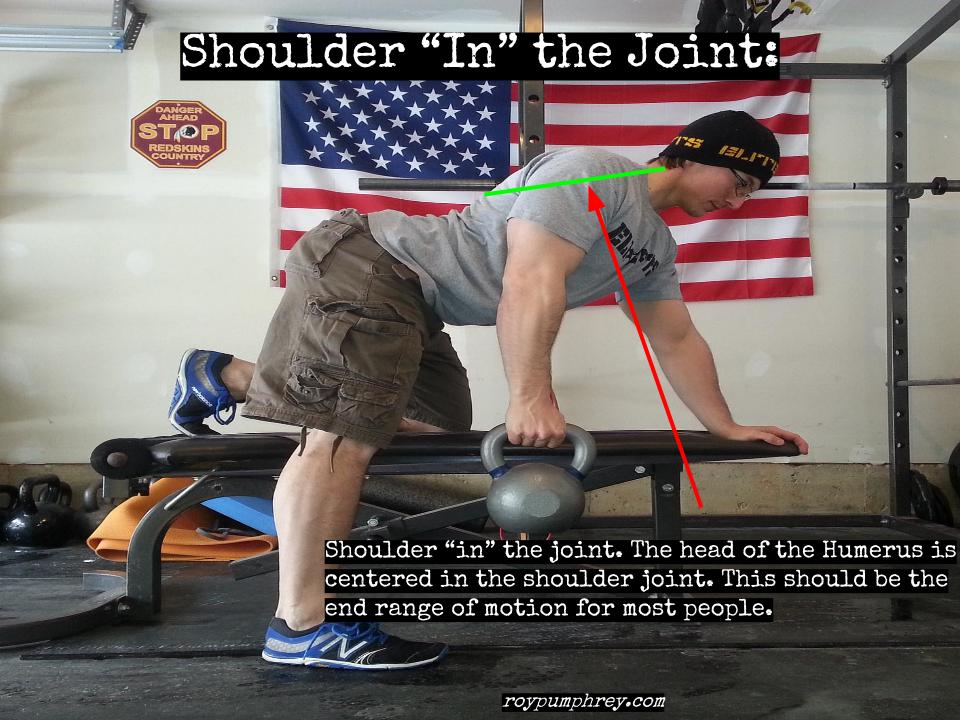
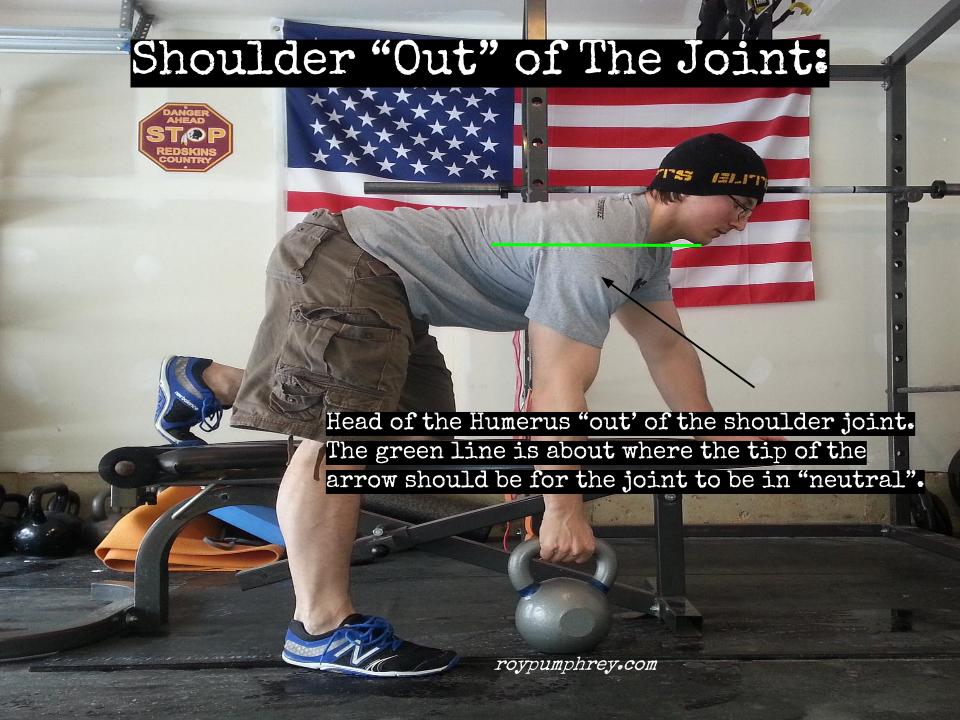
In truth there is some scapula retraction here, but it was so you could see the difference.
Always Shoulders IN the Joint.
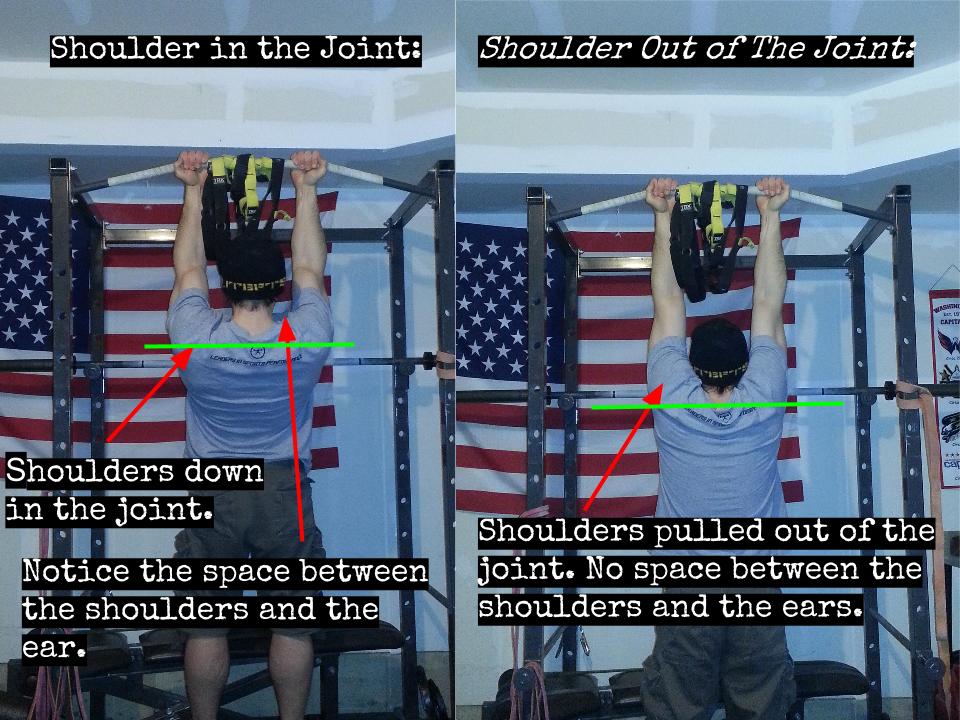
Good Row:
Bad Row:
See how the shoulder-blade moves with the Humerus up in the joint, going behind the ribcage?
Almost like it’s getting out-of-the-way?<——cause it is.
That’s called scapular retraction and you probably need some.
See how the shoulder blades (scapula) stay down, in neutral, the entire movement?
That’s scapular depression and you need some of that too.
Without those you get this:
A whole lot of:
Shoulder Approximation.
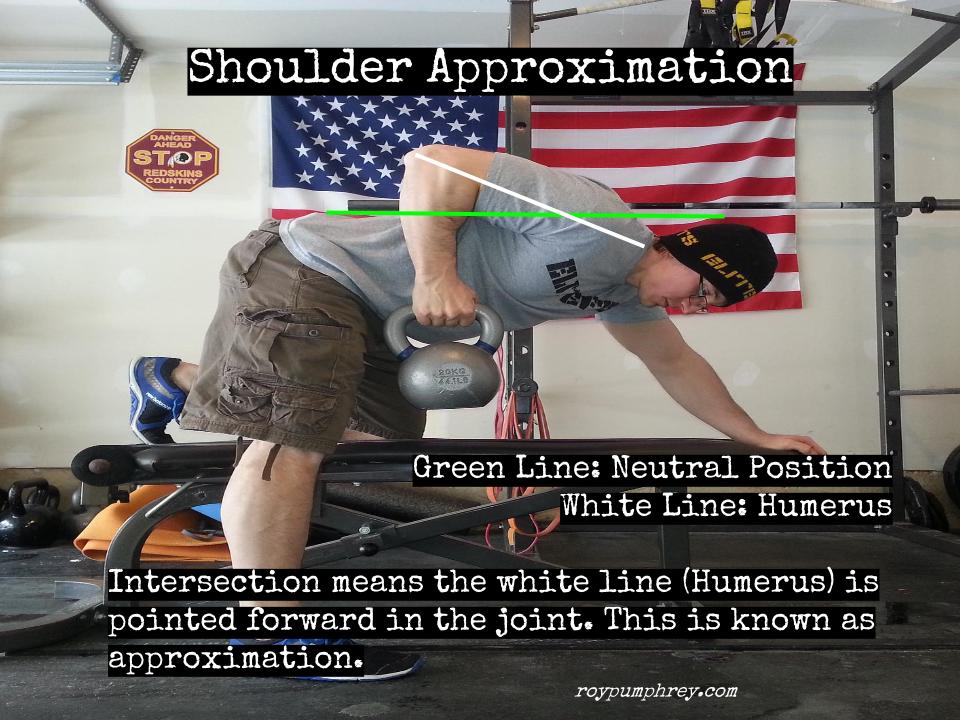
And that’s a bad thing (for most of the people I train, but not everyone in the world).
Now you’re like,
“Ohhh sh@t, my stuff is all over the place”
It’s cool you can fix it.
Step One:
Get Some Thoracic Extension.
You’re not going to get the scapula in the correct position if they’re getting hung up on the ribcage the whole time.
Too many of us are in this jacked up hunched over desk jockey posture.
So we gotta work on fixing that.
Step Two:
Get the itty-bitty muscles to fire.
There’s a solid chance your rhomboids, lower traps, rear delts and serratus aren’t doing a whole lot.
Beyond that there is a solid chance that your lats, while weak as hell, are waaaaaaaaaaaaaay overactive and tight from constantly being in a stretched position and trying to fight against the pull from the anterior (chest) muscles which, due to your desk jockey posture are now overactive and short….
So you should stretch the chest too…
All this means that you NEED to get those “smaller” <—-if you call them stabilization you get punched in the face….HARD, muscles to start firing up and helping to take some of the load and reestablish correct length-tension relationships.
How To:
Really focus on pinching the shoulders together and pulling them down in the joint.
Stuff to Do For Retraction:
Scapula Pinches:
Band Pull Aparts:
TRX Scap Pinch Holds:
Prone Batwing Iso Holds:
Stuff to Do for Scapula Depression:
Wall Slides:
Pulldown ISO Holds:
Just strive to keep the shoulders as far away from the ears as possible and you’ll be ok. <—–yes, there are LOTS of people with excessively downwardly rotated scapula and “sloped shoulders”. These may make the situation worse, if that’s you, don’t do these, they will pull the shoulders down even more. But that’s probably not you.
You’re going to have to strengthen the serratus anterior also because it’s a major player in the rotation of the scapula both upward and out to the side.
Stuff to Strengthen the Serratus:
Serratus Punch:
Scap Pushups:
Half Kneeling Single Arm Press:
Fun Fact: You’re Going to be REALLY bad at the retraction and depression at first…..at first…
Just keep hammering and concentrating and things will eventually happen, but it wont be today, and probably not tomorrow.
Putting it all Together:
Proper shoulder motion is really the interplay of the thoracic spine, scapula, humerus and rotator cuff.
Step Three:
Put yourself in a position to succeed.
Take joints out of the equation.
That way there are fewer things for you to screw up move to compensate for poor movement somewhere else.
The Bench Row:
Because you’re on the bench there’s really no need to worry about not moving the scapula because you can’t fake pinching (retracting) the shoulder blades by rotating the torso.
Point is, the bench takes some of the joints that could create movement out of the equation.
Step Four:
Increase the Motor Control Demand…..add more joints into the mix but you’re still in a position where things are relatively easy to control.
TRX Row:
Now, you’re responsible for the hips and maintaining a “braced”, plank, position.
Granted, it’s pretty easy to let the ribs pop up and lose a neutral ribcage.
But that’s why this is Step Four and not Step Three
Step 5:
It’s on you.
3 Point Row:
The Bench provides a bit of stability, but not really.
Mostly it just allows you to stay in a horizontal position without overtaxing the low back, the real stability in the movement is from the hips and core maintaining the position and resisting rotation.
You’re Good To Go:
Once you can do these successfully, no approximation, shoulder in the joint and a stable scapula you probably don’t have sloppy shoulders anymore.
They might not be perfect, but as long as your striving to follow these points you’re gonna be ok.
- Chest up (thoracic extension)
- Shoulder blades down the ribcage (scapular depression)
- Shoulder blade moves back as you row (scapular retraction)
- Limit approximation
and mostly
Shoulders Always IN the Joint
*IF you have really good humeral control and can “feel” the lat the whole time, you can actually allow the shoulder “out of the joint”/ reach quite successfully. But most of the folks I train, well thats not the case….

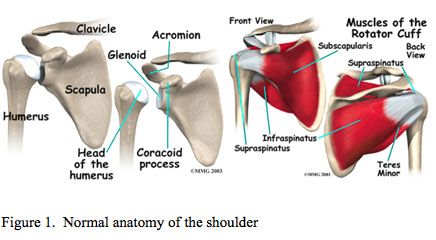


[…] overextend the arms (Approximate the Humerus) at the end range. In the joint, is good […]